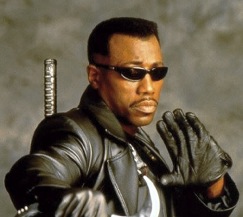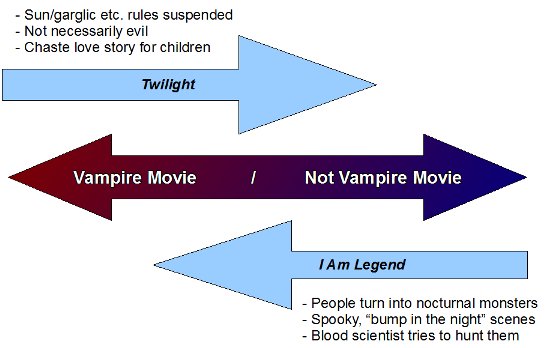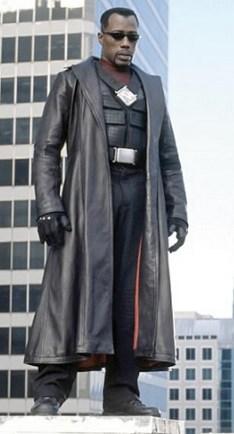Blade – Fenzel
Rather than follow the format strictly today, I’m going to go way over on length here and refine something I talked about in the podcast. I cited Blade as a benchmark movie – and I think it is. It’s not a benchmark movie for quality (I’d just call it “good”), but I consider it to be on the very external border of horror movies.
Once you get to Blade, you know you aren’t watching a horror movie anymore. Let’s talk about the Sorites paradox (“the paradox of the heap”). It usually works with sand, but I’ll try to use something a bit more identifiable.
This is a heap of Republican Beanie Babies:
This is not a heap of Republican Beanie Babies:
If you have fifty Republican Beanie Babies, and that’s a heap, and you take one away, you still have a heap of Republican Beanie Babies. But if you have only one Republican Beanie Baby, that isn’t a heap.
At what point does it cease to be a heap? Three GOP-eanie Babies? 5? Twenty? If you take enough Beanie Babies away so it isn’t a heap anymore, and you add one back, is it a heap now? Either you have to pick something arbitrary, or you have to change the way you use the words so that they don’t mean what they are generally accepted to mean.
The main of the paradox is about the vagueness of language, and how there are things that we understand intuitively that don’t work in logical terms. But it also provides a playground for a number of toys we can play with (intellectual toys, not Babies, Beanie or otherwise). One of those toys is histeresis, or “path-dependence.”
Histeresis says it isn’t enough to know where you are now, you also need to know where you started and how you got to you are – in systems that exhibit histeresis, the starting point affects what the endpoint means and how things function at the endpoint. See Exhibit 1, which compares “I was disappointed by this movie” I Am Legend to “I was disappointed this became a movie” Twilight, on the basis of whether each movie, in its final execution and end state, is a vampire movie or not.
Here, I consider the “starting point” to be the a combination of the core premise on which the movie is built, the expectations that surround the movie, its marketing, the tradition it belongs to, and its initial impressions. By this qualification, Twilight starts as a vampire movie, and I Am Legend start’s out as not a vampire movie (the original book had vampires in it, but the movie definitely doesn’t, which is one reason it makes for good comparison – it has leftover qualities that are easy to find. But the movie definitely doesn’t start out as a vampire movie.).
You’ll see in its execution from its initial core point, Twilight’s trajectory takes it away from other vampire movies. Sunlight doesn’t burn them (I got some “sparkle” for ya right here!), garlic doesn’t faze them, they aren’t gothic monsters, a bunch of them aren’t even really bad and don’t even really have to eat people, and by the way it is a love story for children with no sex in it.
I Am Legend has a trajectory that takes it toward being a vampire movie. There are sort of spooky dark buildings full of these monsters that used to be people, but now they sleep during the day and come out at night to hunt living humans. There’s this doctor who studies arcane diseases who is set up as their adversary and hunts them back, mostly by finding the places they sleep and killing them when they are vulnerable. There are lots of light horror elements, like things that jump out at you and yell “Boo!” There’s some ponderous, grinding existential psychodrama. All of these things are characteristic of vampire movies.
In fact, I Am Legend is more characteristic of vampire movies than Twilight is. However, I Am Legend is not a vampire movie, and Twilight is.
Why? Histeresis.
This system has “path dependence.” Whether you start matters. A vampire movie that becomes a dumb love story can stay a vampire movie until it has lost a great many vampire movie characteristics, but a sci-fi disaster/zombie thriller that moves toward being more of a vampire movie has to hew to almost every single convention in the book in order to become a vampire movie. I think the monsters in I Am Legend could show up with widows’ peaks and Romanian accents and it still wouldn’t quite qualify.
This may seem wrong or invalid, and we can argue the merits of this specific example, but histeresis is still a useful concept that is demonstrable in a lot of cases – the most common among them being the operation of thermostats.
So, back to Blade. First off, Blade is definitely a vampire movie – no doubt about it, that isn’t even in question. But is it a horror movie?
Well, it’s a movie about a small group of plucky survivors facing down an army of the undead lead by an unholy blood god. It has traditional gothic monsters, a hero with a twisted, haunting past, and lots of “Boo!” moments.
But when I say Blade is a benchmark movie for horror, I mean that, in the sense of histeresis, it demonstrates how far you have to go from an initial core premise and expectation of making a horror movie so that what you end up with is not a horror movie anymore.
If you start with a horror movie, and you make something less horror-movie-ish than Blade, it isn’t a horror movie anymore. If you start with a horror movie, and you make something more horror-movie-ish than Blade, it probably is still a horror movie (you could argue that Blade 2 is closer to a horror movie than Blade is, but that’s debatable).
If you start with a movie that is not a horror movie at all, and you make it more like a horror movie, you can get to the point where it’s quite a bit more characteristic of a horror movie than Blade is, and it still doesn’t quite feel like a horror movie (this is how I would classify Se7en). And if you start looking to pinpoint the exact middle – make a hybrid horror/action movie – you end up with something like Evil Dead 2, which is a lot more of a horror movie than Blade, but a milestone on the border of horror in its own right – just a milestone on a different road.
Now, how extremely far away from the expectations of a horror movie do you have to go before it isn’t a horror movie anymore? The answer: Pretty far, but it gets there.
How many Republican Beanie Babies do you have to take out of the heap before you don’t have a heap anymore?
Watch this scene – it starts with Detective Curtis Lemansky from The Shield lured into a vampire den and soaked in a shower of blood. Sounds like a horror movie, right? Well, what comes next might surprise you . . . (this is a strong rated R for blood, violence and language. Might not want to watch it at work.)
I wonder what it would be like if, in the very first scene of a Friday the 13th movie, a hero showed up at a summer camp with an automatic shotgun, a samurai sword, a bunch of incendiary grenades and a crazy boomerang – killed a hundred hockey-masked serial killers and saved the little girl they were about to kill before delivering her safely to the authorities – all inside the first ten minutes.
I tell you what you wouldn’t be watching – a very scary movie. And Blade is not scary at all, because the hero is so physically, technologically and emotionally equipped for the task at hand that you never once doubt that he and his people are more than a match for the vampires.
In Friday the 13th movies, they’ve made more than a dozen of them, and they still can’t finally get rid of one guy! Comparing the Friday the 13th movies to Blade is like making a Total commerical.
Did you know it would take 50,000 Friday the 13th movies to kill as many bad guys as are killed in one movie of Blade? That’s like watching Friday the 13th movies constantly, with no breaks, for ten and a half years!
That’s definitely a signpost that says “Now leaving horror country! Come back soon!”
![[Think Tank] Benchmark Movies](https://www.overthinkingit.com/wp-content/uploads/2009/10/benchmark-carousel.jpg)





No time to over-think, except that you call Alan Rickman’s performance in Robin Hood “ham-fisted.” That means a very bungled performance, but you then say it’s very good. Do you mean his hammed-up performance, in which he would be over-acting? Or … something else? /confused
I have a few benchmark movies based on genre. All of them are closer to the bad end of the spectrum as opposed to being dead center but I still enjoy them and use them as a benchmark.
Action: The Scorpion King starring Dwayne “The Rock” Johnson. Remember when The Rock actual made acceptable movies? I certainly do. While it does have a pretty cliched plot and some questionable dialogue, the action is well done. It also has Michael Clarke Duncan in the role he was meant to play: large, angry pesudo-antagonist to the hero.
Superhero: Ghost Rider, starring Nicholas Cage. It’s faithful enough to the source material to keep my inner Comic Book Guy in check. Cage’s acting switches between being just a bit over-the-top and being too hammy for it’s own good. Special effects aren’t the greatest in the world but they get the job done. It also has a great driving sequence with Ghost Riders in the Sky.
Thriller: Trauma. The name of the lead escapes me but I’ll admit I picked this film up on a whim. It has a decent mystery with a slow burn. The climax has several unexpected reveals within a few minutes of another. They aren’t ultimately satisfying but they do allow the film to end on a disturbing note. It doesn’t hold up under intense scurtiny but given the limited information the viewer is given, it stands up well on its own.
Hate to nitpick an otherwise enlightening article, but your post-script at the end of page 1 loses a lot of its steam when one recalls that “George H.W.” actually refers to Dubya’s dad — meaning that the 1991 movie really only only (supposedly) predicted the results of the 1992 election. (And accurately, at that.)
Keep up the good work! :)
Good call, Jon. My reading kung fu is weak. With apologies to Film Freak Central…
I dunno… I think ham-fisted but awesome is a great way to describe that performance. Ham-fisted doesn’t really mean bungled, it means something like clumsy, too forceful, bereft of subtlety. Like, Carmina Burana is really, REALLY ham-fisted. That doesn’t mean it’s not also good.
So while a ham-fisted surgeon is always bad, a ham-fisted boxer can sometimes do pretty well, and a ham-fisted performance can be brilliant. My nominations for greatest of all time would be Rickman in Robin Hood, Charlton Heston in The Ten Commandments, and Joan Crawford in Straight Jacket.
@stokes: And anything by Brian Blessed. If anyone doesn’t know who he is, look him up and be delighted.
The Boondock Saints is my benchmark. The casting was excellent, the production values so-so, the story semi-forgettable, and the action more than satisfying.
To me, it screams benchmark because it was good enough to warrant a sequel, but not popular enough that it is sill considered a cult hit.
Also, anything with Alan Rickman is awesome by default. The rest of the movie may suck, but Snape/Grueber/Marvin is great.
Aaaah, “Robin Hood: Prince of Theives.” Alan Rickman as the Sheriff of Nottingham is why I say I’ll stab/cut out someone’s eyes with a spoon (jokingly, of course). Best scene evar? “Because it’s dull, you twit, it’ll hurt more.” Over-acted, but so fantastic. And random trivia about the song: Kamen hated it and didn’t want to incorporate it into the score very much because he thought the piano sounded too modern. No problems with the guitar, bass, or drums, though. (Thanks, “Pop Up Video.”)
Greg: I like “Boondock Saints” as an example of that particular action movie, i.e. a gun-fight one. It’s lack of any sort of car chase sequence sets it apart from, say, the third “Die Hard,” a potential benchmark for the genre of action in general.